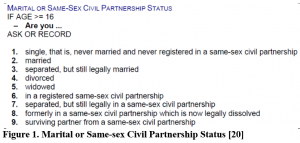The perils of a narrow view of relationship status
Felicity Healey-Benson BSc, PGCE, MBA, MA (HRM), PG Dip CIPD, Dip. NLP, SAC. Dip, FHEA, Academic Assoc. CIPD
In honour of my Dad.
Dad passed away. Within days, Mum fell ill and was hospitalised. In a period of deep distress, my family was immersed in bureaucratic administration: force-fed forms, questionnaires, and registrations. A long line of encounters with badly designed demographic data capture is burnt to my memory. The image of ‘that’ worn pencil, hovering too long over badly prepared paperwork. Single. Married. Divorced. Mum looked across to me. My stomach flipped. A sickening mix of grief, anger, and confusion. A perception of malintent; to obliterate or dissolve relationship bonds by forcing a selection. A guilt-laden choice. Insensitive, distressing, and from a social scientist perspective, packed with potential to cloud judgement.
Mood congruency
The debate of how a ‘widower’ should identify remains an unsettled matter; with views varying from the angry to indifferent. Without delving into the association of grief with the stability of responses [1] I bore witness to the power of question design, its ability to evoke emotion, and impact response. Across academic fields, there is a convergence on the importance of emotion [2], that it can influence judgment and decision-making [3]. Yet overlooked in day-to-day form generating practices.
Cognitive psychologists claim “an individual’s temporary mood state, the transient feeling state perceived by the individual influence evaluations made” [4]. In my mind, ‘mood congruency’ [5], at least that which a badly designed demographic can invoke, should be a priority biasing factor for consideration [6].
Accepted sensitivity
Demographics questions are known to be ‘sensitive’ [7; 8]; often ignoring the complexity of identity [9]. As such they may elicit inaccurate answers [10]. The Institute of Educations’ Research Ethics Guidebook [11] cautions against questions that offend/upset. The justification of inclusion of ‘sensitive data’ variables, however, can present in 3 key ways:
- Research Integrity
As means to accurately describe samples for the purposes of clarity, impacting upon generalization and replication of findings [12; 13], and identification of sampling error [14].
2.Relationship identification:
Sensitive demographic variables can serve as independent variables [12, 15] i.e. “to determine whether identity is causing an individual to do a specific thing” [13, cited in 14] or entered into multivariate models for controlling and confounding effect [16].
- Ethics
To ensure inclusion and diversity [13].
Future Research
Historically, researchers simply asked if one were single or married. Over time this became confusing and/or offensive [17; 18]. Marital status presents as “less nebulous as questions about racial or sexual identity” [19,] but relationships remain deeply complicated. The National Statistics Office [20] provide guidance on a gamut of relationship possibilities [figure 1].
Participants fractured by loss should not need to recalculate identities unfairly [21]. This applies to all “sensitive” demographic variables, in academic or other data-generating contexts, to anyone who would feel aggrieved or distressed to be excluded, misrepresented or inappropriately labelled. Should we not all pledge to adhere to this promise throughout our research or business endeavours.
We know what we are, but not what we may be. – William Shakespeare
https://www.emergentthinkers.com
References
- DiBiasio E. L., Clark, M.A., Gozalo, P.L, Spence, C., Casarett, D.J., & Teno, J.M. (2015) ‘Timing of Survey Administration After Hospice Patient Death: Stability of Bereaved Respondents’, Journal of Pain Symptom Management, 50(1), pp.17-27.
- McLemee, S. (2003) ‘Getting emotional’, Higher Ed. 2003 49(1), pp. 1-14.
- Clore, G.L & Huntsinger, J. R. (2007) ‘How emotions inform judgment and regulate thought’, Trends in Cognitive Science, 11(9), pp. 393-9.
- Heide, M. & Gronhaug, K. (1991) ‘Respondent’s Moods As a Biasing Factor in Surveys: an Experimental Study’, in NA – Advances in Consumer Research Volume 18, eds. Holman, R.H. & Solomon, M.R. Provo, UT : Association for Consumer Research, pp. 566-575.
- Mayer, J.D, Gaschke, Y.N., Braverman, D. & Temperance, T.W. (1992) ‘Mood-congruent recall is a general effect’, Journal of Personality and Social Psychology, 63 (1) pp. 119-132.
- Mazor, K.M., Clauser, B.E., Field, T., Yood, R.A. & Gurwitz, J.H. (2002) ‘A demonstration of the impact of response bias on the results of patient satisfaction surveys’, Health Serv, 37(5) pp.1403-17.
- Weaver, D. A. (1999) ‘The Accuracy of Survey-Report Marital Status: Evidence from Survey Records Matched to Social Security Records’, ORES Working Paper Series, No. 80, Division of Economic Research, Social Security Administration Office of Research, Evaluation and Statistics (online). Available at: https://www.ssa.gov/policy/docs/workingpapers/wp80.pdf [Accessed 11/11/2018].
- Tourangeau, R. & Yan, T. (2007)’ Sensitive Questions in Surveys’, Psychological Bulletin, 133(5) pp. 859-883.
- BrckaLorenz, A., Zilvinskis, J., & Haeger, H. (2014) ‘Categorizing identities: Race, gender, disability, and sexual orientation’, Symposium conducted at the meeting of Association for Institutional Research, Orlando, FL. (online). Available at: http://cpr.indiana.edu/uploads/Categorizing%20Identities%20Handout%20FINAL%202.pdf [Accessed 3/11/2018].
- Choi, B.C. & Pak, A.W. (2004) ‘A cataloge of biases in questionnaires’, Prev Chronic Dis., 2(1), pp 1-13.
- The Institute of Education (n.d.) Asking questions of participants, The Research Ethics Guidebook (online). Available at: http://www.ethicsguidebook.ac.uk/Asking-questions-of-participants-100 [Accessed 7/11/2018].
- Salkind, N. J. (2010) ‘Encyclopaedia of research design’, SAGE Publications: Thousand Oaks doi: 10.4135/9781412961288
- Hughes, J. L., Camden, A.A. & Yangchen, T. (2016) ‘Rethinking and Updating Demographic Questions: Guidance to Improve Descriptions of Research Samples’, Fall 2016, Psi Chi Journal of Psychological Research, 21(3), pp. 138-151.
- GESIS (n.d) Socio-demographic variables (online). Available at: https://www.gesis.org/en/gesis-survey-guidelines/instruments/survey-instruments/socio-demographic-variables/ [Accessed 9/11/2018].
- DeFranzo, S.E. (2012) Why Use Demographic Questions in Surveys? (online). Available at: https://www.snapsurveys.com/blog/demographics-questions-surveys/ [Accessed 8/11/2018].
- Pourhoseingholi, M.A., Baghestani, A.R. & Vahedi, M. (2012) ‘How to control confounding effects by statistical analysis’, Gastroenterol Hepatol Bed Bench, 5(2), pp. 79-83.
- Makadon, H., & Tillery, B. (2013) ‘Clinical rational for collecting sexual orientation and gender identity data’. In Institute of Medicine, Collecting sexual orientation and gender identity data in electronic health records: Workshop summary (pp. 5–14). Washington, DC: The National Academies Press.
- White, R. (2015) ‘Are you asking the right demographic questions?’ (online). Available at: http://www.languageintelligence.com/ blog/post/asking-demographic-questions-international/ [Accessed 7/11/2018].
- Fryrear, A. (2016) ‘How to Write Better Demographic Survey Questions (With Examples)’[blog]. Available at https://www.surveygizmo.com/resources/blog/how-to-write-better-demographic-questions/ [Accessed 8/11/2018].
- Office for National Statistics (2015) ‘Harmonised Concepts and Questions for Social Data Sources Primary Principles, Version 3.1’ (online). Available at: p2demographicinfomay15_tcm77-181120.pdf [Accessed 9/11/2018].
- Fleet, C.B. (2017)’ ‘Ex’ Does NOT Mark The Spot: Respecting The Widowed And Their Late Spouses’ (online). Available at: https://www.huffingtonpost.com/carole-brody-fleet/death-of-spouse_b_5032965.html?guccounter=1 [Accessed 7/11/2018].
Keywords: quantitative research, survey design, widow, sensitive demographics, mood congruency, relationship status


